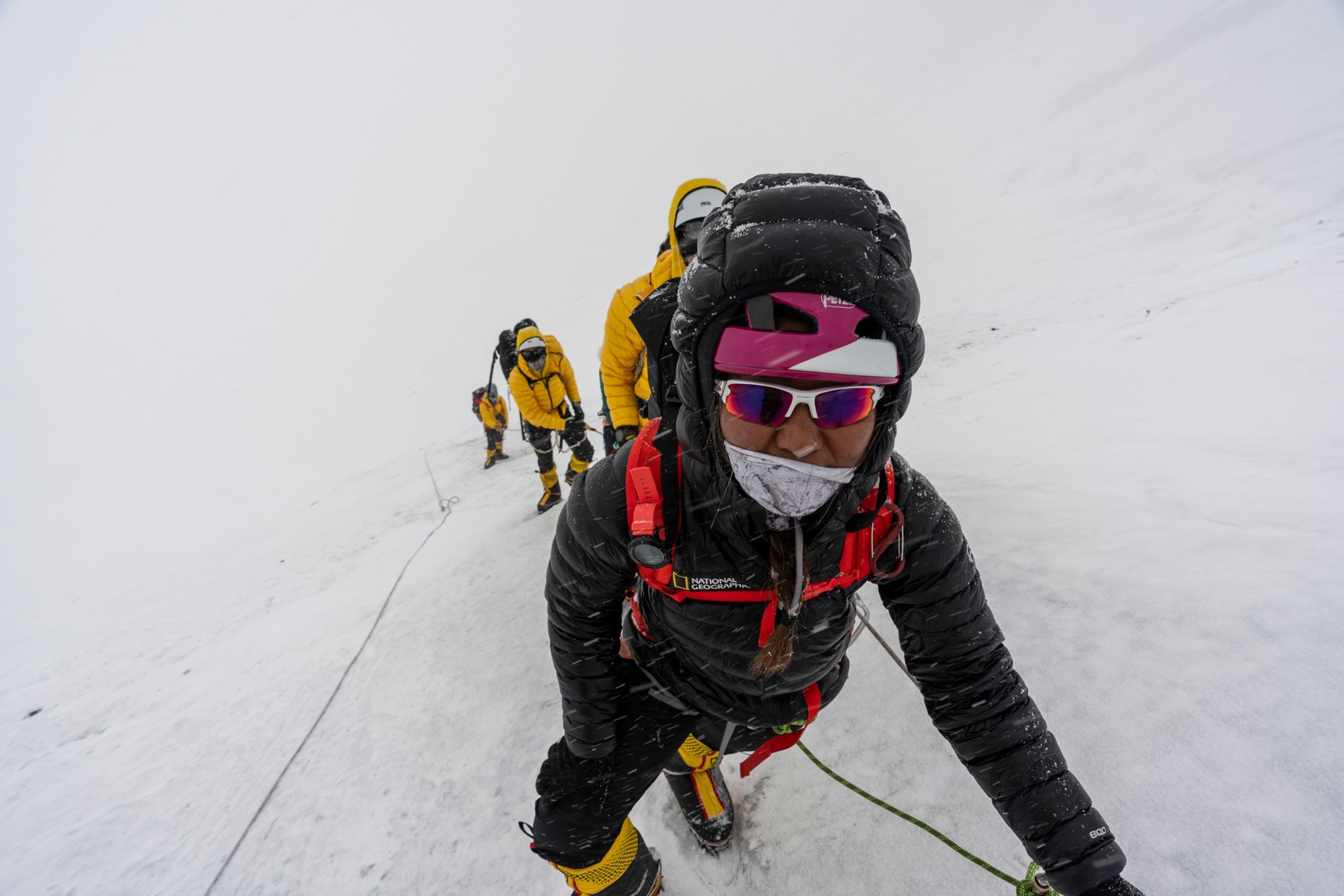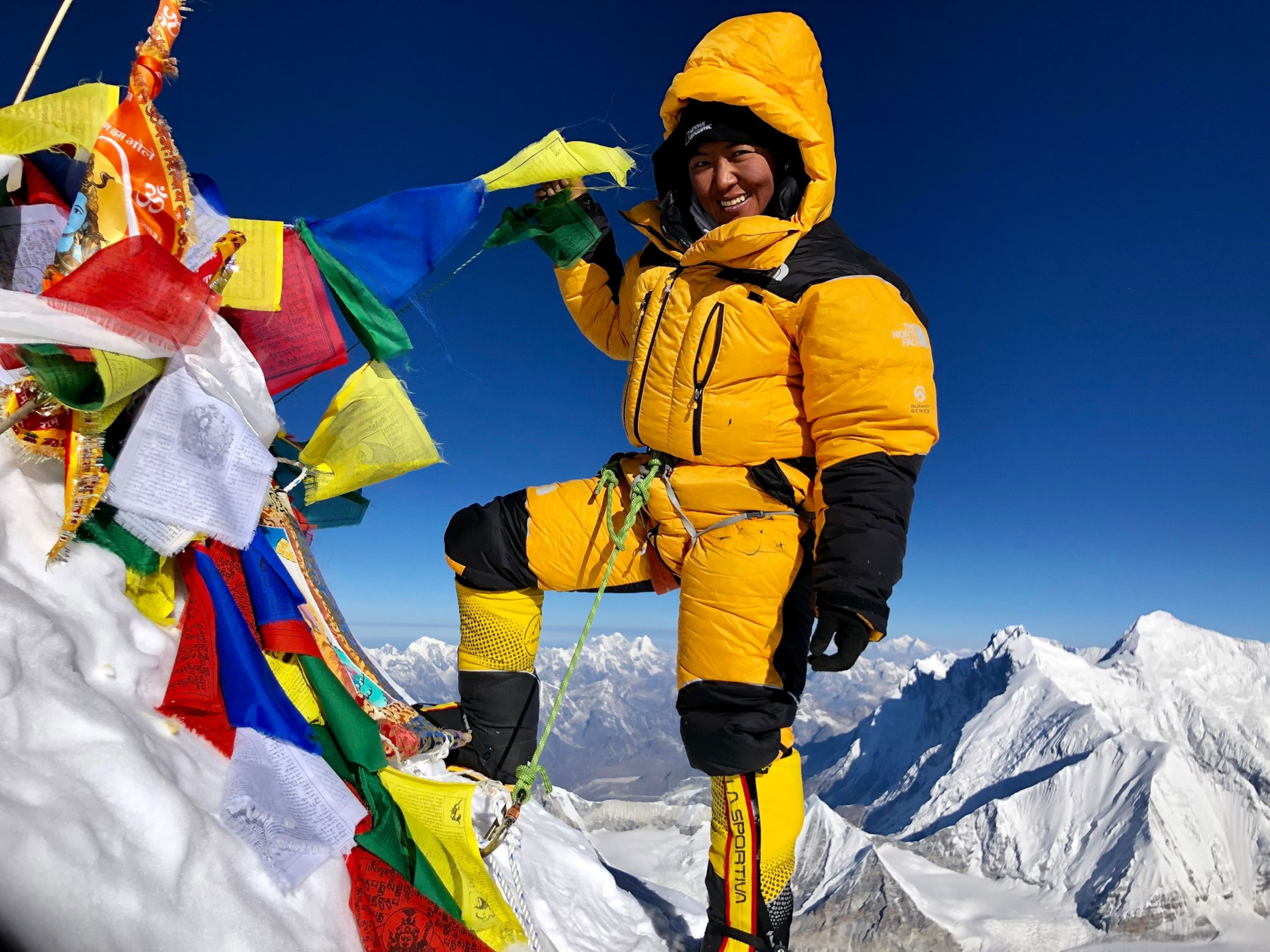
Here’s how one elite Everest guide would improve safety on the mountain
Top Nepali climber Dawa Yangzum Sherpa was caught in the Everest traffic jam this season. Here's how she would improve the experience.
Once upon a time, young Nepali women who wanted to climb mountains had few female role models to look to. Then came Dawa Yangzum Sherpa, 28, who has blazed a bright trail up some of the world’s most difficult and dangerous mountains, including Everest (multiple times), the even more daunting K2, and numerous others. In 2017 she became the first South Asian woman to earn an International Federation of Mountain Guide Association certification, and this spring, she helped lead National Geographic Society’s scientific expedition on Mount Everest, which sought to study the effects of climate change on the region.
After witnessing the dangerous traffic jams on Everest this season, Dawa Yangzum recently shared her thoughts on what she would do to improve safety on the mountain.
You first summited Mount Everest in 2012, so this wasn’t your first time on the mountain. Did you notice any differences right away?
I saw a large number of Chinese and Indian clients and many new expedition operators. There were a lot of inexperienced climbers—and even those who take a helicopter to skip crossing the Khumbu Icefall. This is not allowed, but a certain company did it with Chinese climbers.
What do you think were some of the issues on the mountain this year?
There were so many people on Everest, many more than expected, due to the limited weather windows to summit. We also had a very unhealthy competition between very experienced guides and guides with no experience at all.
Sometimes, smaller teams blindly follow larger teams with little or no planning. The larger teams, such as Alpine Ascents and IMG, have more manpower and better facilities, including better weather forecasters and stronger guides. Smaller teams are kind of hedging that if something goes wrong, they are in better hands if they are closer to larger teams.
You mentioned in a Facebook post after your Everest climb that you had to step over bodies on your route. Tell us about that experience.
We encountered three bodies of people who died this year, including two Russians below Camp IV. There was also an Indian lady's body near the Balcony. Obviously there were dead bodies from prior years, too, including Scott Fisher's. People don't move the bodies because it's too dangerous to disconnect from the ropes. I heard the Russians were trying to bring their bodies down, but I am not sure that was successful.
What do you think could be the cause of those deaths?
One of the most important aspects we need to know about as guides is how to use supplemental oxygen, since most people depend on supplemental oxygen above the South Col at 25,938 feet. Many deaths happened due to lack of supplemental oxygen. In some cases, there was a wrong calculation made on the amount of oxygen required.

Some Western outfitters blame Nepali guiding companies for the problems on Everest this year. Is that true?
Well, there are a couple of excellent Nepali guiding companies with very capable guides in their team. If you look at a number of rescues done in the last few years, most are done by these guides working for local companies. There are also a couple of local guiding companies who have not done a good job, which could prove fatal on Everest.
Overcrowding has also been blamed for this year’s issues. How bad was it?
It was quite bad. Obviously, all climbers would want to go at their own speed, but with just one rope, that was extremely difficult for everyone. Many times, other guides had to step up and solve the bottlenecking problem. On May 23, there was one Indian woman in front of the line. Since she was quite slow; it created a long traffic jam. Finally, one of my guide friends, Jangbu Sherpa from Alpine Ascents, had to rope her up and pull her to the side to manage. We had so many similar situations while going up and down.
Are inexperienced climbers the biggest problem on Everest?
They are the biggest problem, closely followed by inexperienced and untrained guides.
What can be done to solve these problems?
First all, climbers should be required to climb at least one or two other 7,000- to 8,000-meter peaks in Nepal to get altitude and climbing experience before climbing Everest. This requirement has to be in Nepal, because climbing culture in Nepal is different than in the U.S. or Europe. The biggest difference is Nepal is obviously much higher in elevation, which causes more altitude sickness. The highest elevation in the U.S., 20,310-foot Denali, is similar to Camp I on Everest. Beyond the clients, even the Western guides require Sherpa help in Nepal. Also, most of the climbs in Nepal involve fixed lines.
Second, the route-fixing team should set the ropes in early May, so the climbers have more weather-window options to choose from. Usually fixed lines are in place by early May. Unfortunately, this year the weather was extremely cold and it was not until mid-May that they were able to fix lines.
Third, there has to be a minimum skill and experience requirement for the guides on Everest. For example, they should have received training from organizations such as the Khumbu Climbing Center and the Nepal Mountaineering Association, and they should also have climbed at least one 7,000- to 8,000-meter peak in Nepal.
What other changes would you make?
The Nepal government should limit the permits and set regulations on climbers and guides. The government definitely should not increase the permit price because nature and adventure is for everyone.
China only gave 300 permits, and although the Nepali government gave around 390 permits, the permit also required another 390 guides. It's not about the number of permits, but more about the quality of climbers and the quality of guides who should be allowed on the mountain.
Can Sherpas solve the problem of inexperienced climbers themselves?
Sherpas are much stronger than other climbers, but they are not super humans. After dragging a client for hours and hours, Sherpas also get tired, and sometimes suffer from frostbite. Some of the Sherpas I saw, who had been dragging their clients for many hours, looked completely blue on their faces.
Sometimes, rich clients hire three or more Sherpas. What often happens is such clients often receive more than necessary support to reach the top. Then the client is literally dragged down by his Sherpas when he cannot walk himself. This is where the Sherpas get tired and get into trouble, and even lose their fingers. This is when Sherpas from other teams have to step in to help.
The National Geographic Society team completed their scientific work just below the summit, but you weren’t done for the season. You went on to climb 27,838-foot Makalu, the world's fifth tallest mountain, and became the first Nepali woman to climb the peak—and you did it in a speedy 21 hours, instead of the typical four days. Why did you decide to continue your climbing after Everest?
I had always thought of climbing Makalu since that day I saw that mountain from the summit of Everest in 2012. The crowded conditions on Everest meant that I couldn’t speed climb it without oxygen, which was my original goal. So Makalu made sense.

How was your experience on Makalu compared to your time on Everest?
It was very quiet on Makalu, and when I reached the summit, there were only two other climbers. The strange thing was, we only saw seven people on the entire mountain, which is the first time I had seen so few people on an 8,000-meter peak. It was just so different from Everest, which was more like a booming shanty town. In fact, I became nervous at the summit since there were only three of us on the entire huge mountain. At the same time, the quietness and the challenge of climbing made this one of my best climbing experiences ever, and it has made me more confident about climbing going forward.
